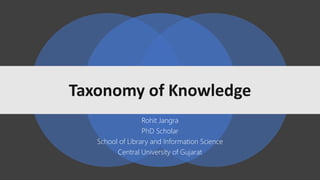
Taxonomy of Knowledge Management
- 1. Rohit Jangra PhD Scholar School of Library and Information Science Central University of Gujarat Taxonomy of Knowledge
- 2. Introduction • Taxonomy is all about organizing and classifying. • The word “Taxonomy” is derived from two Greek terms : taxis and nomos. • Taxis – the arrangement or ordering of things • Nomos – anything assigned, usage or custom, law or ordinance. • Taxonomy is a subject-based classification that arranges the terms in a controlled vocabulary , and allows related terms to be grouped together and categorized in ways that make it easier to find the correct term to use. • Taxonomy is useful when searching for, or describing, an object.
- 3. Terminology: data, information, knowledge • Data: any fact • Metadata/Information: the act or fact of informing Data about data Provides context Relationship with other data objects • Knowledge: the fact or state of knowing the perception of fact or truth Interpreted data, “understands” data and information to refine or fulfil a query Experiential data
- 4. SECI MODEL Sympathized Knowledge: Shared mental models and technical skills Conceptual Knowledge: Analogies & metaphors of products & processes Systematic Knowledge: Prototypes or new technologies Operational Knowledge: Project management, production process, new product usage and policy implementation
- 5. Representation of Knowledge Knowledge Representation Model Classification System Ontology Data model Taxonomy Subject Classification System
- 6. Concept Synonym Characteristics Definition Model PURPOSE: knowledge representation simplified representation of knowledge about phenomena Ontology concept model; concept system DESCRIPTION: concepts model for the description of knowledge about concepts Data model DESCRIPTION: data formal model for the description of data in an IT system Classification System classification PURPOSE: classification system for the division of phenomena into classes Taxonomy CONTENTS: categories classification system for the division of categories of a domain Subject classification system subject classification CONTENTS: subject fields classification system for the division of phenomena into subject fields
- 7. Taxonomy Architectures There are four types of taxonomy architectures: •Flat •Hierarchical •Faceted •Network
- 8. Flat Taxonomies • Group content into a controlled set of categories • Alphabetical listing of people is a flat taxonomy • Lists of countries or states • Lists of currencies • Controlled vocabularies • List of security classification values
- 9. Hierarchical Taxonomies • Hierarchical taxonomies structure content into at least two levels • Hierarchies are bi-directional • Each direction has meaning • Moving up the hierarchy means expanding the category or concept • Moving down the hierarchy means refining the category or the concept
- 10. Facet Taxonomies • Facets can describe a property or value • Facets can represent different views or aspects of a single topic • The contents of each attribute may have other kinds of taxonomies associated with them • Facets are attributes - their values are called facet values • Meaning in the structure derives from the association of the categories to the object or primary topic • Put a person in the center of a facet taxonomy
- 11. Network Taxonomy • Taxonomy which organizes content into both hierarchical & associative categories • Combination of a hierarchy & star architectures • Any two nodes in a network taxonomy may be linked • Categories or concepts are linked to one another based on the nature of their associations • Links may have more complex meaningful than we find in hierarchical taxonomies
- 12. We start with a generalized term, and keep getting more and more specific. Almost anything may be classified according to some taxonomic scheme, as long as there’s a logical hierarchy.
- 13. Two Types of Taxonomies: Browse and Formal Browse Taxonomy – Yahoo https://in.yahoo.com/?p=us
- 15. Browse Taxonomies: Strengths and Weaknesses Strengths • Browse is better than search • Context and discovery • Browse by task, type, etc. Weaknesses • Catalogs, alphabetical listings, Subject matter, functional, publisher, document type • Vocabulary and nomenclature Issues • Problems with maintenance, new material • Little relationship between parts. • No foundation for standards
- 16. Formal Taxonomies: Strengths and Weaknesses Strengths • Fixed Resource – little or no maintenance • Communication Platform – share ideas, standards • Infrastructure Resource • Controlled vocabulary and keywords Weaknesses • Difficult to develop and customize • Don’t reflect users’ perspectives • Users have to adapt to language
- 17. Varieties of Taxonomy/ Text Analytics Software • Taxonomy Management • Text Analytics • Auto-Categorization, Entity Extraction • Sentiment Analysis • Software Platforms • Content Management, Search • Application Specific • Business Intelligence
- 18. Vendors of Taxonomy/ Text Analytics Software Attensity Multi-Tes Business Objects – Inxight Nstein Clarabridge SchemaLogic ClearForest Teragram Data Harmony / Access Innovations Wikionomy Lexalytics Wordmap
- 19. Bloom’s Taxonomy
- 20. thank you
Hinweis der Redaktion
- The SECI model is a well known conceptual model that was first proposed by Nonaka
- In one sentence, Bloom's Taxonomy is a hierarchical ordering of cognitive skills that can, among countless other uses, help teachers teach and students learn.
